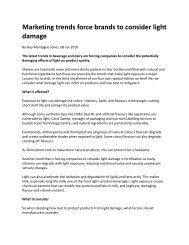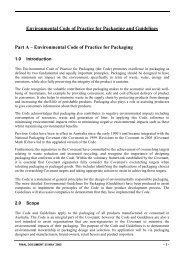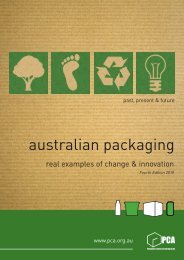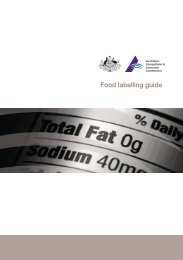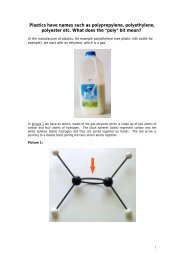australian packaging: issues and trends - the Packaging Council of ...
australian packaging: issues and trends - the Packaging Council of ...
australian packaging: issues and trends - the Packaging Council of ...
You also want an ePaper? Increase the reach of your titles
YUMPU automatically turns print PDFs into web optimized ePapers that Google loves.
vice versa. This enables relatively seamless progress from initiation <strong>of</strong> product requirements through<br />
to order placement, manufacturing, delivery, invoicing <strong>and</strong> distribution. The increasing<br />
implementation <strong>of</strong> <strong>packaging</strong> optimisation s<strong>of</strong>tware will dovetail with developments in logistics<br />
technology to increase total pack efficiency. Deliveries within <strong>the</strong> logistics chain will become<br />
increasingly complex, with direct store delivery, central warehousing, distribution centres, product<br />
picking <strong>and</strong> robotic scanning. The role <strong>of</strong> <strong>the</strong> logistics pr<strong>of</strong>essional will become increasingly important<br />
to <strong>the</strong> <strong>packaging</strong> industry.<br />
Supply chain management<br />
All companies in <strong>the</strong> supply chain are under constant pressure to drive down costs, including <strong>the</strong> cost<br />
<strong>of</strong> <strong>packaging</strong>. At every point in <strong>the</strong> supply chain, costs are added. Reducing those costs, simplifying<br />
<strong>the</strong> supply chain <strong>and</strong> increasing efficiency is now a major goal. Economies <strong>and</strong> competitive advantage<br />
are to be gained from a more integrated, collaborative, co‐operative <strong>and</strong> long‐term approach to <strong>the</strong><br />
supply chain by <strong>the</strong> companies involved.<br />
Convenience <strong>packaging</strong><br />
Consumers are dem<strong>and</strong>ing a wider range <strong>of</strong> products <strong>and</strong> greater segmentation (by size, flavour)<br />
within those products. Convenience/quick preparation foods providing smaller/single serve portions<br />
are in dem<strong>and</strong>. Pre‐cut, pre‐portioned, smaller, ready‐to‐consume products are increasingly popular,<br />
reflecting <strong>the</strong> importance <strong>of</strong> convenience to today's consumers. Packs that go from <strong>the</strong> shelf or bin<br />
straight into <strong>the</strong> fridge or straight into <strong>the</strong> oven. Packs that are easy to open, dispense, reseal <strong>and</strong><br />
store. Convenience <strong>packaging</strong> goes beyond <strong>the</strong> essential purpose <strong>of</strong> preserving <strong>and</strong> protecting <strong>the</strong><br />
product. Consumers want conveniently packaged food products that can be quickly made into meals<br />
without sacrificing quality. This is obvious in <strong>the</strong> range <strong>of</strong> products displayed in supermarkets—<br />
microwavable products, salad kits, zippered pouches <strong>and</strong> modified atmosphere <strong>packaging</strong>—that<br />
extends shelf‐life <strong>and</strong> maintains freshness. A by‐product <strong>of</strong> this dem<strong>and</strong> will be an increase in <strong>the</strong><br />
amount <strong>of</strong> <strong>packaging</strong> per food unit.<br />
Marketability<br />
<strong>Packaging</strong> sells products. Many <strong>of</strong> <strong>the</strong> <strong>trends</strong> listed above—lifestyle changes, greater product<br />
differentiation, competitive pressures—are putting an even greater premium on <strong>the</strong> look, sales<br />
appeal <strong>and</strong> quality <strong>of</strong> retail <strong>packaging</strong>. Greater versatility <strong>of</strong> product presentation will also be called<br />
for as an expression <strong>of</strong> <strong>the</strong> increasingly diverse <strong>and</strong> sophisticated dem<strong>and</strong>s <strong>of</strong> consumers. There will<br />
be an increasing dem<strong>and</strong> for higher quality graphics <strong>and</strong> promotional links between graphics <strong>and</strong><br />
advertising.<br />
<strong>Packaging</strong> for an ageing population<br />
The proportion <strong>of</strong> <strong>the</strong> elderly (over 65 years) is expected to increase to 22% <strong>of</strong> <strong>the</strong> population in <strong>the</strong><br />
first half <strong>of</strong> <strong>the</strong> century compared with <strong>the</strong> current 12% approximately. The ‘greying’ <strong>of</strong> <strong>the</strong><br />
Australian population will increase <strong>the</strong> emphasis on <strong>the</strong> provision <strong>of</strong> easy‐opening systems,<br />
consistent with ‘tamper evident’ closures. Readability <strong>of</strong> labels for <strong>the</strong> aged <strong>and</strong> visually impaired will<br />
also require attention in <strong>the</strong> designing <strong>and</strong> labelling <strong>of</strong> <strong>packaging</strong>. Given <strong>the</strong>ir numbers <strong>and</strong> affluence,<br />
marketing will reflect this changing composition <strong>of</strong> <strong>the</strong> population.




